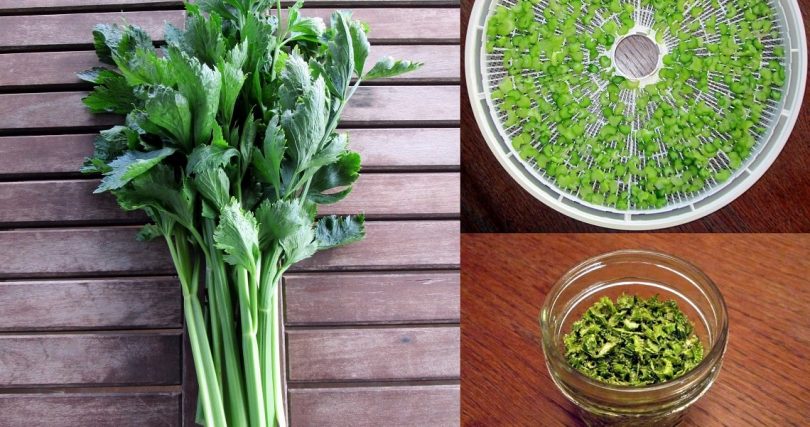Celery is a strong alkaline vegetable. It contains ingredients with powerful health benefits. According to Healthline:
- Celery is a great source of important antioxidants.
- Celery reduces inflammation.
- Celery supports digestion.
- Celery is rich in vitamins and minerals with a low glycemic index.
- Celery has an alkalizing effect.
A stalk a day can help you stay in the best condition. Like most people, you may have it as an ingredient in soup. You may also add it to your smoothie.
A Simple Guide to Dehydrating Celery at Home
How to prepare celery for dehydration
A concern in dehydrating celery (and other vegetables) is that dehydrated celery stalks lose their original flavor and color during the process. Some of these dehydrated vegetables can turn out rather bitter and pale.
Fortunately, you can remedy this concern easily.
Before you start dehydrating celery, it’s vital to blanch the plant first. Blanching will help preserve the vegetable’s flavor and its green color as you proceed.
To start dehydrating celery, wash each stalk thoroughly and bring water (in a large container) to a boil.
Then follow these steps:
First, cut off the bottom area and the top ends of each celery stalk. A celery’s bottom is a whitish area while its top is leafy.
Some people prefer to throw these “excess” parts away because they are relatively hard to chew.
But you may also store them or use them for later. Just put them in a separate container and then freeze them for your stock.
Then, cut each celery stalk into thirds. After, dump them in boiling water and leave them be for about 1 minute.
Then, prevent residual heat from cooking the celery. It’s important to remove the vegetables from boiling water after a minute. Otherwise, they will get cooked.
To do this, you have 2 options:
- Immerse the celery in ice water. And then leave them be for 1 minute.
- Filter out the boiling water. And then run the celery under cold water, and leave for 1 minute.
Finally, slice each blanched stalk into ½”-thick crescents. The vegetables are now ready for dehydration and you may refrigerate them for 24 hours before starting the process.
A short video: How to blanch herbs and vegetables
Different methods of dehydrating celery
You can use different methods to dehydrate celery. Because each method is effective, you may choose the one that offers the most convenience to you.
Here are the common methods of dehydrating celery.
Dehydrating celery in the oven
- First, arrange the chopped celery stalks properly on the oven’s tray. Make sure to leave some space between each piece.
- Then, set the temperature below 150 F.
- Then, put the tray in the oven. Avoid fully closing the oven door. And instead, use a wooden spoon or a dish towel to keep the door ajar.
- Finally, wait for about 6-8 hours. When finished, let the products cool for 10 minutes at room temperature.
Dehydrating celery in the food dehydrator
- First, arrange the chopped celery stalks properly on the food dehydrator’s tray. Make sure to leave some space between each piece.
- Then, set the dehydrator at 135 F.
- Finally, put the tray in the dehydrator and wait. The waiting period can take around 6-8 hours and will result in crispy-dry celery.
READ ALSO: Which Food Dehydrator is Right for You
How to Store Dehydrated Celery
After the dehydrating process, you can now store the dried products. Celery is a top choice of preppers because it has a shelf life for several years.
But while it’s good for long-term storage, dehydrated celery will only last long if you store it properly. As the proper preparation and dehydration processes, the proper storage technique is as important.
Here’s how you can properly store dehydrated celery:
- First, transfer the cooled celery into glass containers. And then make sure to shut the lids tightly.
- Then, list down the date of the dehydration process. It’s a good practice to write down the date on the glass containers.
- Finally, store the containers anywhere you want so long as they’re away from extreme cold temperature or direct heat.
Final thoughts
Despite the vegetable’s high-water content, dehydrating celery is fairly easy.
While it may not taste as flavorful as the original, dehydrated celery contains the same essential nutrients as fresh celery. And if you want to cling to its original flavor, you can rehydrate the celery.
You can dehydrate and store as much celery as you want. So long as you have enough containers and storage space, you may keep a huge stock.
SEE ALSO: Growing Celery Indoors





